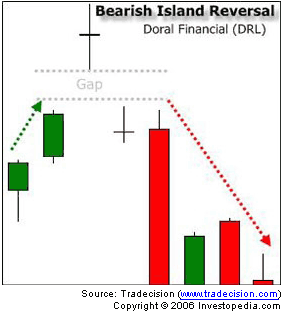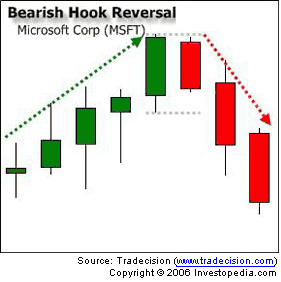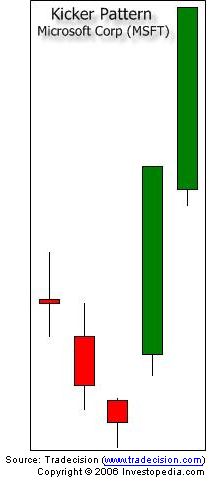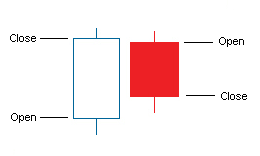
Chartered Accountant
935 Points
Joined December 2007
Advanced Candlestick Patterns
Candlestick patterns can give you invaluable insight into price action at a glance. While the basic candlestick patterns can tell you what the market is thinking, they often generate false signals because they are so common. Here we introduce you to more advanced candlestick patterns, with a higher degree of reliability, as well as explore how they can be combined with gaps to produce profitable trading strategies.
Island Reversal Patterns
Island reversals are strong short-term trendreversal indicators. They are identified by a gap between a reversal candlestick and two candles on either side of it. Here are two examples that occurred on the chart of Doral Financial (DRL).

Figure 1 |

Figure 2 |
Here are some important things you need to consider when using this pattern:
- Entry: Confirming the reversal pattern - When looking for an island reversal, you are looking for indecision and a battle between bulls and bears. This type of scenario is best characterized by a long-ended doji candle that has high volume occurring after a long prior trend; it is important to look for these three elements to confirm any potential reversal pattern.
- Exit: Defining the target and stop - In most cases, you will see a sharp reversal (as seen in Figs. 1 and 2) when using this pattern. This reversal pattern does not necessarily indicate a medium- or long-term reversal, so it would be prudent to exit your position after the swing move has been made. If the next candle ever fills the gap, then the reversal pattern is invalidated, and you should exit prudently.
Island reversals can also occur in "clusters" - that is, in a multi-candle reversal pattern, such as an engulfing, as opposed to a single candle reversal. Clusters are easier to spot, but they often result in weaker reversals that are not as sharp and take longer to occur.
Hook Reversal Patterns
Hook reversals are short- to medium-term reversal patterns. They are identified by a higher low and a lower high compared to the previous day. Figures 3 and 4 are two examples that occurred on the chart of Microsoft Corp. (MSFT).

Figure 3 |

Figure 4 |
There are several important things to remember when using this pattern:
- Entry: Confirming the reversal pattern - If the pattern occurs after an uptrend, then the open must be near the prior high, and the low must be near the prior low. If the pattern occurs after a downtrend, then the opposite is true. As with the island reversal pattern, we are also looking for high volume on this second candle. Finally, the stronger the prior trend, the more reliable the reversal pattern.
- Exit: Defining the target and stop - In most cases, you will see a sharp reversal (as seen in Figs. 3 and 4) when using this pattern. If the next candle shows a strong continuation of the prior trend, then the reversal pattern is invalidated, and you should exit quickly, but prudently.
San-Ku (Three Gaps) Patterns
San-ku patterns are anticipatory trend reversal indicators. In other words, they do not indicate an exact point of reversal; rather, they indicate that a reversal is likely to occur in the near future. They are identified by three gaps within a strong trend. Here is an example that occurred on the chart of Microsoft Corp. (MSFT).

Figure 5 |
Here are some important things to remember when using this pattern:
- Entry: Confirming the reversal pattern - This pattern operates on the premise that prices are likely to retreat after sharp moves because traders are likely to start booking profits. Therefore, this pattern is best used with other exhaustion indicators. So, look for extremes being reached in indicators such as the RSI (relative strength index), MACD (moving average convergence divergence) crossovers, and other such indicators. It is also useful to look for volume patterns that suggest exhaustion.
- Exit: Defining the target and stop - In most cases, when using this pattern, you will see a price reversal shortly after the third gap takes place (as seen in Fig. 5). However, if there are any breakouts on high volume after the last gap, then the pattern is invalidated, and you should exit quickly, but prudently.
Kicker Patterns
Kicker patterns are some of the strongest, most reliable candlestick patterns. They are characterized by a very sharp reversal in price during the span of two candlesticks. Here's an example that occurred on the Microsoft (MSFT) chart.

Figure 6 |
Here are some important things you need to remember when using this pattern:
- Entry: Confirming the reversal pattern - This kind of price action tells you that one group of traders has overpowered the other (often as a result of a fundamental change in the company), and a new trend is being established. Ideally, you should look for a gap between the first and second candles, along with high volume.
- Exit: Defining a target and stop - When using this pattern, you will see an immediate reversal, which should result in an overall trend change. If the trend instead moves sideways or against the reversal direction, then you should exit quickly, but prudently.
Using Gaps with Candlesticks
When gaps are combined with candlestick patterns and volume, they can produce extremely reliable signals. (For further reading, see Playing The Gap.) Here is a simple process that you can use to combine these powerful tools:
- Screen for breakouts using your software or website of choice.
- Make sure that the breakouts are high volume and significant (in terms of length).
- Watch for reversal candlestick patterns (such as the ones mentioned above) after the gap has occurred. This will typically happen within the next few bars, especially if the bars are showing indecision after a long trend.
- Take a position when such a reversal occurs.
|
Attempting to play reversals can be risky in any situation because you are trading against the prevailing trend. Do make sure that you keep tight stops and only enter positions when trades meet the exact criteria. (To learn more, see Retracement Or Reversal: Know The Difference.)
Conclusion
Now you should have a basic understanding of how to find reversals using advanced candlestick patterns, gaps and volume. The patterns and strategies discussed in this article represent only a few of the many candlestick patterns that can help you better understand price action, but they are among the most reliable. For further reading, see The Art Of Candlestick Charting - Part 1, Part 2, Part 3 and Part 4.
by Justin Kuepper, (Contact Author | Biography)
Justin Kuepper has many years of experience in the market as an active trader and a personal retirement accounts manager. He spent a few years independently building and managing financial portals before obtaining his current position with Accelerized New Media, owner of SECFilings.com, ExecutiveDisclosure.com and other popular financial portals. Kuepper continues to write on a freelance basis, covering both finance and technology








 CAclubindia
CAclubindia
